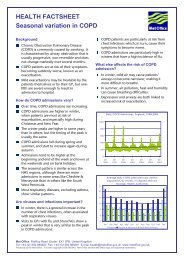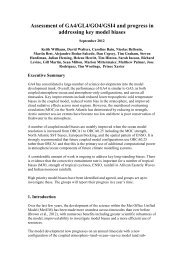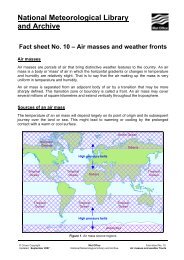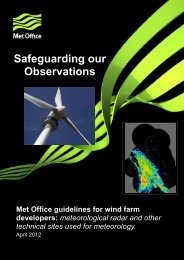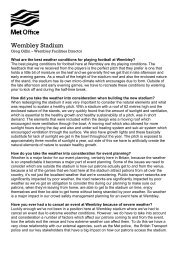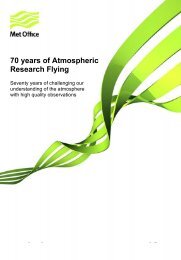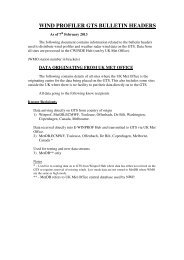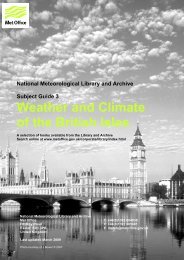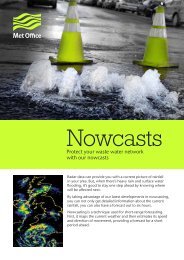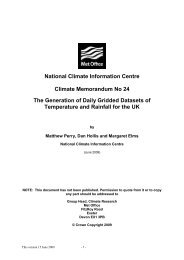StormTracker user guide - Met Office
StormTracker user guide - Met Office
StormTracker user guide - Met Office
You also want an ePaper? Increase the reach of your titles
YUMPU automatically turns print PDFs into web optimized ePapers that Google loves.
Data provenance and guidanceThe messages are primarily designed to give an indication of the <strong>Met</strong> <strong>Office</strong> global model’s forecast track oftropical cyclones, which are known to exhibit some skill. Explicit forecasts of maximum wind speed are notgiven as the model (at its current resolution) cannot resolve the wind field with sufficient detail. However,a qualitative indication of forecast wind strength is given based on the model’s relative vorticity field (at the850 hPa level).Regional Specialised <strong>Met</strong>eorological CentresNational Hurricane Center, Miami (Caribbean Sea, Gulf of Mexico, North Atlantic and easternNorth Pacific oceans east of 140° W)Japan <strong>Met</strong>eorological Agency, Tokyo (Western North Pacific Ocean from Malay peninsula to 180° E)Indian <strong>Met</strong>eorological Department, New Delhi (Bay of Bengal and the Arabian Sea)The Central Pacific Hurricane Center, Honolulu, Hawaii (North Pacific Ocean 140-180° W)Météo France á La Réunion (South Indian Ocean from African coast to 90° E)<strong>Met</strong>eorological Service, Nadi, Fiji (South Pacific Ocean east of 160° E and north of 25° S)Other tropical cyclone warning centresThe Bureau of <strong>Met</strong>eorology, Australia (Southern hemisphere 90-160° E)<strong>Met</strong>Service, Wellington, New Zealand (South Pacific Ocean east of 160° E and south of 25° S)Joint Typhoon Warning Center, Pearl Harbor, Hawaii (West of 180° E)Canadian Hurricane Centre, Halifax, Canada (Canadian Atlantic shores)2. Latest weatherLatest weather data is data that is fed into <strong>StormTracker</strong> from observations sources the <strong>Met</strong> <strong>Office</strong> collatesfrom around the world. It represents what has happened in the recent past, and will be overwritten whennew data is available.a. Data sourcesThere are four sources of latest weather information available in <strong>StormTracker</strong>:Label Source Type Frequency ResolutionCloud — IRGlobal SatellitecompositeLatest high resolutioninfra-red satelliteglobal composite3 hourly Approx 16 km onEquatorCloud — visibleGlobal SatellitecompositeLatest high resolutionvisible satellite globalcomposite3 hourly Approx 16 km onEquatorSea surfaceTemperatureForecast OceanAssimilation Model(FOAM)Latest globalobserved sea surfacetemperature from5 metre depth12 hourly 40 kmWind speed Synops / buoys Latest global windspeed and direction1/3/6 hourly(depending onreporting station)N/A (location ofreporting station)b. Data typesSee above27 <strong>StormTracker</strong> User Guide v3



